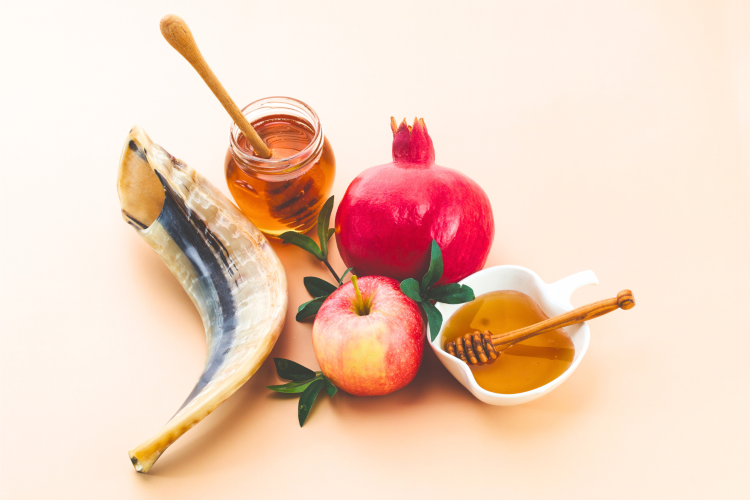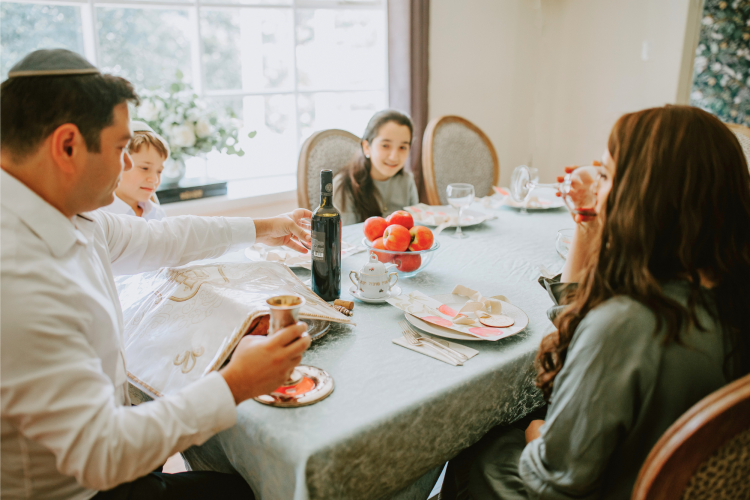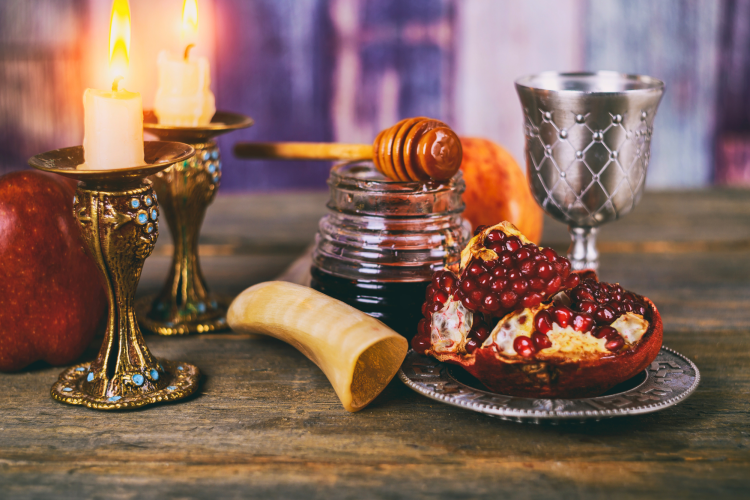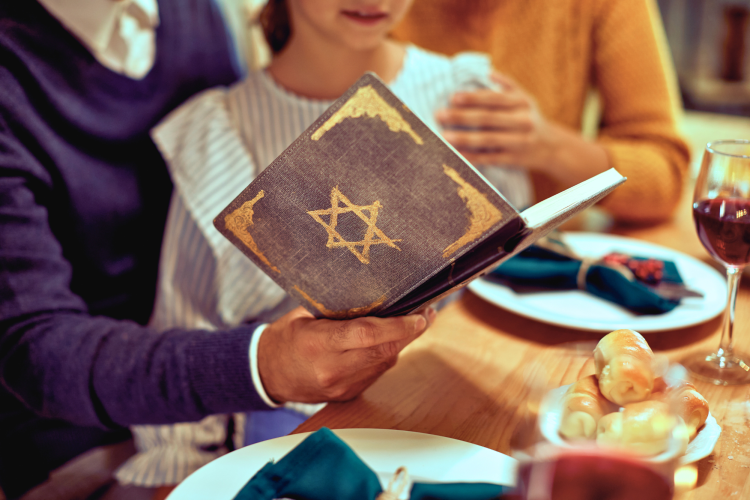What Is Rosh Hashanah? Guide to the Jewish New Year

What is Rosh Hashanah? Rosh Hashanah is the start of the New Year in the Jewish calendar and a moment to take stock of the year gone by while looking forward to the year ahead. Compared to January first, Rosh Hashanah is considerably more serious. It's a time for reflection when Jewish people can think about their priorities in life and what's important to them.
Rosh Hashanah is also a celebration of the creation of the world and marks a fresh start. On this holy day, Jewish people are not expected to work. Instead, they attend special synagogue services, enjoy festive meals with loved ones and engage in traditions that encourage spiritual renewal. To learn more about what Rosh Hashanah is, keep reading this guide where we explore interesting Rosh Hashanah facts, Rosh Hashanah greetings, customs and ways to honor the holiday meaningfully.
Jump to Section
What Is Rosh Hashanah And How Is It Celebrated?

Rosh Hashanah means 'head of the year' in Hebrew and it's a two-day celebration that's full of traditional Rosh Hashanah food, prayer and creative rituals.
A Brief History of Rosh Hashanah
So, what is Rosh Hashanah really all about and where does it come from? The rabbinic tradition designates Rosh Hashanah as the spiritual start of the year and scholars believe it may have evolved from ancient enthronement ceremonies or harvest festivals. Later Jewish teachings gave it powerful new meaning and it became known as the anniversary of the creation of the world, or more precisely, the creation of humankind. This theme of creation and renewal is woven throughout the celebration to this day. At its heart, this festival is a time when Jews are invited to reset, reflect and realign their lives.
When Is Rosh Hashanah?

To fully understand the question "What is Rosh Hashanah?" it's essential to recognize its place within the Jewish calendar. Unlike the Gregorian calendar most people use every day, the Hebrew calendar is a lunar-based calendar, which means Jewish holidays shift dates each year when translated to the secular calendar. As such, Rosh Hashanah doesn't land on January 1 like the typical New Year, but rather falls in early Autumn.
In 2025, for example, Rosh Hashanah begins at sunset on September 22 and continues through nightfall on September 24. This marks the start of the Hebrew year 5786 according to the Jewish calendar. The celebration begins on the first day of the Hebrew month of Tishrei, which, according to Jewish tradition, is the anniversary of the world's creation.
How Long Is Rosh Hashanah?
Rosh Hashanah spans two days and marks the beginning of the Ten Days of Repentance, also known as the Days of Awe. Preparation for this holiday actually begins even earlier. In the week leading up to it, Jews recite special prayers known as Selichot, asking for forgiveness and spiritual clarity.
Rosh Hashanah itself is sometimes called Yom Hadin, the Day of Judgment. It is believed that during this time, God opens the Books of Life and Death, deciding each person's fate for the coming year, and this decision is finalized on Yom Kippur. To fully grasp the question "What is Rosh Hashanah?" it's helpful to view it not as an isolated holiday, but as the emotional and spiritual gateway to the High Holy Days. It's a deeply introspective period that sets the tone for the year ahead.
How Is Rosh Hashanah Celebrated At Home?

As mentioned, Rosh Hashanah marks the beginning of the High Holidays and is seen as a chance to pause, reset and reconnect with family, tradition and one's purpose. For those observing the holiday from home, the celebration typically begins at sundown and lasts for a total of two days. To prepare, families often set the table with symbolic items, like two candles with candlesticks, kosher wine (often poured into a kiddush cup), a round challah loaf, apples and honey and a festive meal. While a Passover meal commemorates freedom, Rosh Hashanah meals are all about sweetness and are filled with hope for the year ahead.
The night that Rosh Hashanah begins, it's customary to have a family meal, as well as a lunch on the first day; some people also have a second-day lunch. During this time, traditional dishes are served, including gefilte fish, brisket or roast chicken, matzo ball soup, carrot tzimmes and pomegranate seeds.

Unlike Hanukkah food, which is often fried in oil to honor the miracle of the menorah, Rosh Hashanah dishes focus on symbolic ingredients meant to inspire a fresh start. Sephardic Jews have a Rosh Hashanah seder featuring foods with names that are puns in Hebrew. For example, serving a fish head allows one to say, "May we be like the head and not the tail," expressing a hope to take on more of a leadership role in one's life or community in the coming year.
Before eating, the host lights the candles and recites blessings over them, the wine and the challah. A beautiful moment follows where everyone dips apples in honey to symbolize hopes for a sweet new year. It's also customary to greet others with "L'Shanah Tovah," which means "for a good year."
Some families will even decorate their homes with fresh flowers and fruit to commemorate the new year and mark fresh, new beginnings. If you have a shofar of your own, it makes a beautiful centerpiece for your home table. You can even have your kids make pretend ones to practice with and get involved in the holiday preparations. Rosh Hashanah is also a time to consider how to do more Tzedakah, or philanthropy, through community projects, taking a stand on important issues or giving to charities.
Rosh Hashanah Facts
If you're curious and have the burning question, "What are 5 facts about Rosh Hashanah?" here are a few that help highlight the richness and uniqueness of the holiday:
1. Trying New Fruits

During the second evening of Rosh Hashanah, families make it a point to enjoy a fruit they haven't tried before or one that's new to the current season. This meaningful tradition represents embracing the fresh opportunities and sweet moments that lie ahead in the coming year. In the same vein, many also wear new clothes or resolve to enter the new year with a fresh mindset. A sweet, round challah (kitkah bread usually eaten on the Sabbath), often filled with raisins, is also part of the food menu for Rosh Hashanah. The round shape represents the full cycle of the year, while the raisins are a sweet addition, advancing the theme of a "sweet new year."
2. Pomegranate Symbolism
The pomegranate holds a special place in Jewish tradition. It's believed to have 613 seeds, representing the 613 mitzvot (commandments; good deeds or acts of kindness) in the Torah. Eating it on Rosh Hashanah is a reminder of spiritual abundance and the importance of good deeds.
3. The Book of Life

One of the most powerful Rosh Hashanah facts is the belief that this is when the Jewish people's fate for the coming year is written in the Book of Life. And so, the ten days between Rosh Hashanah and Yom Kippur are an opportunity to reflect, seek forgiveness and improve our actions before that fate is sealed.
4. Sounding of the Shofar
A defining tradition of Rosh Hashanah is the sounding of the shofar, a trumpet made from a ram's horn. It serves as a spiritual wake-up call to examine our behavior and return to our values. Hearing the shofar is considered a core mitzvah of the holiday and is often why Rosh Hashanah is called the Feast of Trumpets.
5. Tashlich or Casting Off Sins

Another cherished ritual is Tashlich, which involves walking to a natural body of flowing water, often after synagogue services, and symbolically casting away sins by tossing breadcrumbs or pebbles into the stream. It's a physical act of letting go and moving forward in preparation for the new year.
Understanding what Rosh Hashanah is also means appreciating how Jewish families come together during this time to share special meals that celebrate renewal and hope. Traditionally, Jewish families attend synagogue on the night Rosh Hashanah begins and on the first and second days as well, to hear the shofar sounded.
Synagogue services during Rosh Hashanah are rich, day-long experiences filled with music, prayer, scripture readings and meaningful talks from religious leaders. A highlight is hearing the ancient story of Abraham and Isaac from the Torah. Once the formal worship ends, congregants often walk together with their rabbi to a nearby stream, river or lake to perform the Tashlich ceremony.
It's also common to send out family greeting cards on Rosh Hashanah with warm wishes for a "Shanah Tovah" (a good year), further emphasizing the theme of community and connection. The entire experience, from the solemn tones of the shofar to the joyful meals shared at home, is designed to help worshippers reflect on their lives and step into the new year with purpose.
What Is Rosh Hashanah FAQs
Is It Okay To Say Happy Rosh Hashanah?

During Rosh Hashanah, it's customary for Jewish people to exchange warm wishes as the new year begins. One of the most common greetings you'll hear is "L'shanah tovah," a Hebrew phrase that means "for a good year." A shorter, more casual version often used is "Shana Tovah," which translates to "have a good year!"
If you're wondering, "Is it okay to say Happy Rosh Hashanah?", the answer is yes. While using the traditional Rosh Hashanah greeting is appreciated, saying "Happy Rosh Hashanah" is also considered thoughtful and respectful, especially if you're not familiar with Hebrew phrases. Just as many people set intentions and reflect at the start of January, Rosh Hashanah is also a time for reflection and renewal, making it a meaningful moment to explore your own New Year's resolution ideas in the spirit of starting fresh.
What's The Difference Between Yom Kippur And Rosh Hashanah?
Although Rosh Hashanah and Yom Kippur are both important holidays in the Jewish calendar, they serve very different purposes. Rosh Hashanah is the celebration of the Jewish New Year, observed over two days with traditions centered on reflection and hope for a sweet year ahead. Yom Kippur, on the other hand, is a solemn Day of Atonement marked by a 25-hour fast and intense spiritual introspection. Among the most interesting Rosh Hashanah facts is that fasting is not part of the tradition, unlike Yom Kippur, where refraining from food and drink is central to the observance.
Now that you know the answer to the question "What is Rosh Hashanah?" and understand its beautiful traditions, you can appreciate why this holiday holds such deep meaning for Jewish families around the world. Rosh Hashanah offers everyone an opportunity to experience the warmth of community while embracing the possibilities of the year to come.
For even more fun ideas to celebrate the new year, check out other experiences happening on Classpop!

